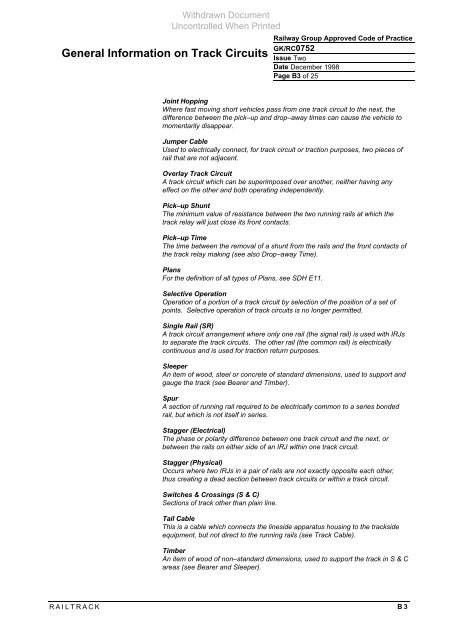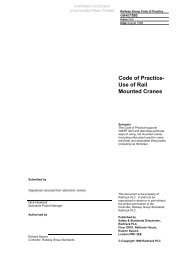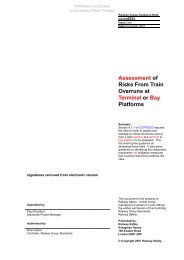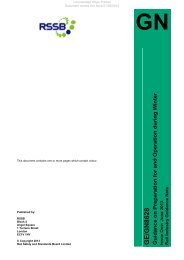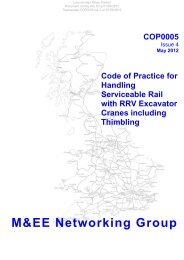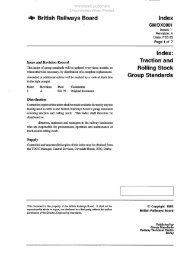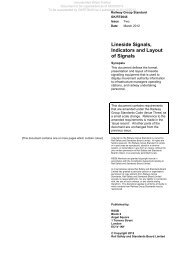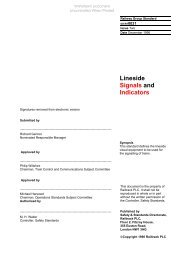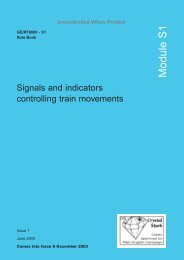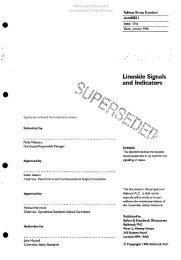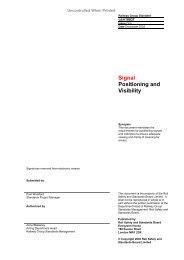General Information on Track Circuits - RGS Online
General Information on Track Circuits - RGS Online
General Information on Track Circuits - RGS Online
Create successful ePaper yourself
Turn your PDF publications into a flip-book with our unique Google optimized e-Paper software.
Withdrawn Document<br />
Unc<strong>on</strong>trolled When Printed<br />
<str<strong>on</strong>g>General</str<strong>on</strong>g> <str<strong>on</strong>g>Informati<strong>on</strong></str<strong>on</strong>g> <strong>on</strong> <strong>Track</strong> <strong>Circuits</strong><br />
Railway Group Approved Code of Practice<br />
GK/RC0752<br />
Issue Two<br />
Date December 1998<br />
Page B3 of 25<br />
Joint Hopping<br />
Where fast moving short vehicles pass from <strong>on</strong>e track circuit to the next, the<br />
difference between the pick–up and drop–away times can cause the vehicle to<br />
momentarily disappear.<br />
Jumper Cable<br />
Used to electrically c<strong>on</strong>nect, for track circuit or tracti<strong>on</strong> purposes, two pieces of<br />
rail that are not adjacent.<br />
Overlay <strong>Track</strong> Circuit<br />
A track circuit which can be superimposed over another, neither having any<br />
effect <strong>on</strong> the other and both operating independently.<br />
Pick–up Shunt<br />
The minimum value of resistance between the two running rails at which the<br />
track relay will just close its fr<strong>on</strong>t c<strong>on</strong>tacts.<br />
Pick–up Time<br />
The time between the removal of a shunt from the rails and the fr<strong>on</strong>t c<strong>on</strong>tacts of<br />
the track relay making (see also Drop–away Time).<br />
Plans<br />
For the definiti<strong>on</strong> of all types of Plans, see SDH E11.<br />
Selective Operati<strong>on</strong><br />
Operati<strong>on</strong> of a porti<strong>on</strong> of a track circuit by selecti<strong>on</strong> of the positi<strong>on</strong> of a set of<br />
points. Selective operati<strong>on</strong> of track circuits is no l<strong>on</strong>ger permitted.<br />
Single Rail (SR)<br />
A track circuit arrangement where <strong>on</strong>ly <strong>on</strong>e rail (the signal rail) is used with IRJs<br />
to separate the track circuits. The other rail (the comm<strong>on</strong> rail) is electrically<br />
c<strong>on</strong>tinuous and is used for tracti<strong>on</strong> return purposes.<br />
Sleeper<br />
An item of wood, steel or c<strong>on</strong>crete of standard dimensi<strong>on</strong>s, used to support and<br />
gauge the track (see Bearer and Timber).<br />
Spur<br />
A secti<strong>on</strong> of running rail required to be electrically comm<strong>on</strong> to a series b<strong>on</strong>ded<br />
rail, but which is not itself in series.<br />
Stagger (Electrical)<br />
The phase or polarity difference between <strong>on</strong>e track circuit and the next, or<br />
between the rails <strong>on</strong> either side of an IRJ within <strong>on</strong>e track circuit.<br />
Stagger (Physical)<br />
Occurs where two IRJs in a pair of rails are not exactly opposite each other,<br />
thus creating a dead secti<strong>on</strong> between track circuits or within a track circuit.<br />
Switches & Crossings (S & C)<br />
Secti<strong>on</strong>s of track other than plain line.<br />
Tail Cable<br />
This is a cable which c<strong>on</strong>nects the lineside apparatus housing to the trackside<br />
equipment, but not direct to the running rails (see <strong>Track</strong> Cable).<br />
Timber<br />
An item of wood of n<strong>on</strong>–standard dimensi<strong>on</strong>s, used to support the track in S & C<br />
areas (see Bearer and Sleeper).<br />
RAILTRACK B3


